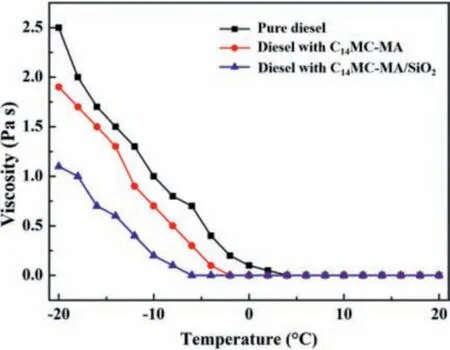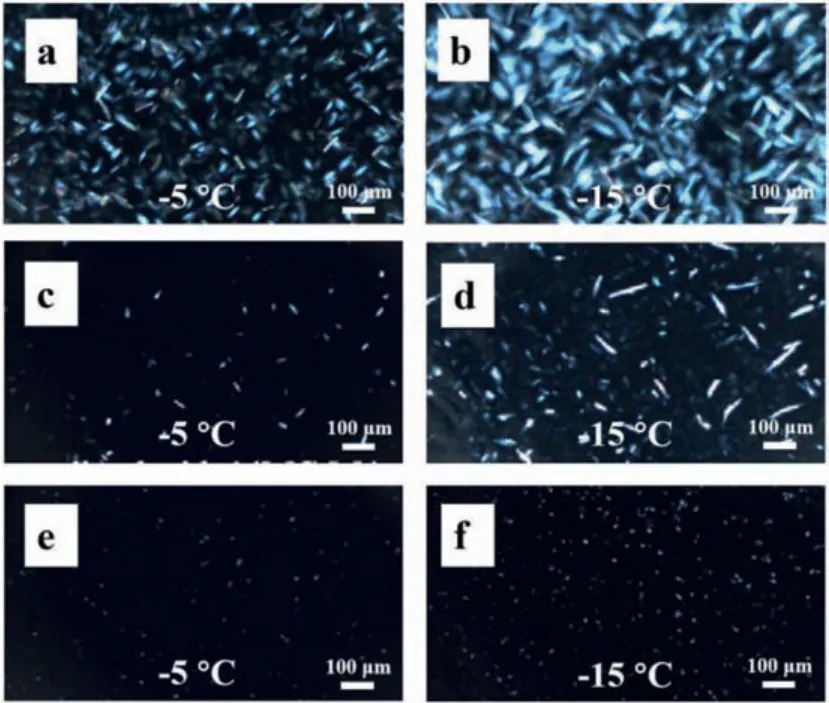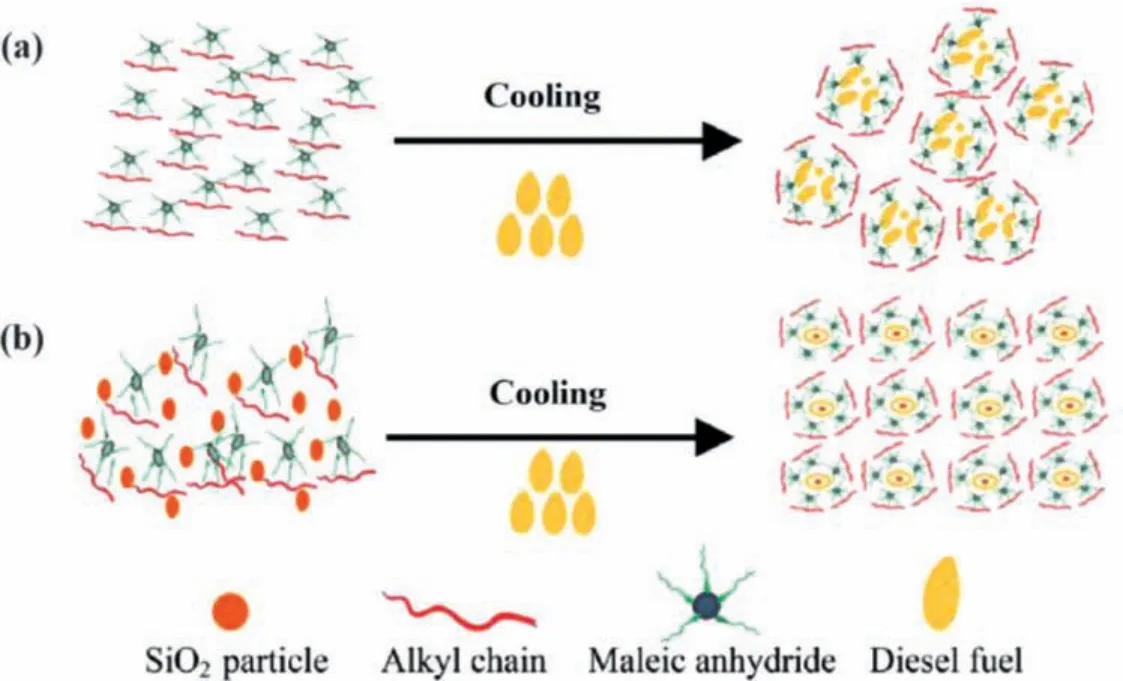Effect of nanocomposite as pour point depressant on the cold flow properties and crystallization behavior of diesel fuel
Yun Xue, Fengfei Chen, Bin Sun, Hulin Lin, Bin Di, Sheng Hn,**
a School of Chemical and Environmental Engineering, Shanghai Institute of Technology, Shanghai 201418, China
b School of Chemistry and Chemical Engineering, Shihezi University, Shihezi 832003, China
c School of Materials Science and Engineering, University of Shanghai for Science and Technology, Shanghai 200093, China
Keywords:Diesel fuel Pour point depressant Nano-hybrid Cold flow properties Crystallization behavior
ABSTRACT The high effective nano-hybrid pour point depressant (PPD) has attracted extensive attention for its potential application in improving the cold flow properties of diesel fuel.In this paper, the nano-hybrid PPD was prepared by melt-blending method using three different alkyl chain lengths (i.e., tetradecyl, hexadecyl, and octodecyl) of n-alkyl methacrylate-maleic anhydride copolymers (R1MC-MA, R1 = C14, C16, C18)and SiO2 nanoparticles.The effect of those nano-hybrid PPDs on the cold filter plugging point (CFPP)and solidifying point (SP) depressing of diesel fuel were studied.Results indicated that nano-hybrid PPD showed much better performance on diesel fuel.The diesel fuel treated with 0.2 wt% C14MC-MA/SiO2 nano-hybrid PPD exhibited the best depression in CFPP and SP by 6 °C and 18 °C, respectively, which higher than that of single C14MC-MA.Viscosity-temperature curves and polarized optical microscopy were conducted to explore the performance mechanism; and results presented that nano-hybrid PPD of C14MC-MA/SiO2 could effectively lower the low-temperature viscosity, and modify the crystallization behavior and crystal morphology of diesel.Therefore, the cold flow properties of diesel were significantly improved.
Diesel is a fuel derived from petroleum, widely used in industry, agriculture, transportation, and national defense [1].Nevertheless, with the temperature decreasing, the wax crystals continue to grow and create three-dimensional network, thereby entrapping the remaining fuel in network crystal, causing the cold flow problems such as the fuel pipeline and filter plugging, and impairing the engine performance [2,3].
To overcome such a problem, some solutions have been developed to improve the cold flow property.Adding polymeric pour point depressants (PPDs) has been proven to be a wellrecognized and efficient solution [4-8].In the field of traditional PPDs, the most widely used types of PPDs are polymethyl acrylate (PMA), ethylene vinyl acetate copolymer (EVA) and polyα-olefin (PAO) [4-8].However, these traditional PPDs still have some improvable effects on improving the cold flow properties of diesel fuel, especially in improving the cold filter plugging point(CFPP).To further overcome those problems, nano-technology and nano-materials have received considerable attention.Many polymer/inorganic nanocomposites or nano-hybrid materials have been considered and introduced into the improvement of rheological properties of crude oil [9-13].Some studies indicate that the nanohybrid PPDs not only have the characteristics of nanoparticles(i.e., mechanical, thermal, magnetic and electrical), but also has the advantages of polymer, such as good dispersion and oil solubility[14-16].The long-term stability of the nanohybrid PPDs was superior to that of conventional polymeric PPDs [16].The addition of nanocomposites or nanohybrid PPDs can significantly reduce the pour point and apparent viscosity of crude oils, as the nanohybrid PPD prevented the aggregation of wax crystals, reduced the amount and size of wax crystals, and retarded the starting temperature of crystallization.It seems that the nano-hybrid PPDs may open a new way to improve the flowability of diesel since nanoparticles have the good dispersion ability, high adsorption affinity and the large surface area [17].However, the research on nano-hybrid PPDs to improve the cold flowability of diesel fuel is seldom involved.In our previous works [18], three commercials polymeric PPDs (PMA, EVA and PAO) were selected and recombined with the organically modified nano-clay.The effect of nano-hybrid PMA,EVA, and PAO on the cold flow properties of diesel was comparatively investigated.All these nano-hybrid PPDs have a positive effect on the CFPP and solidifying point (SP) of diesel compared with the conventional PPDs.Among them, nano-hybrid PMA in the mass ratio of 4:1 (PPD:nano-clay) has proved to be the best cold flow improver for diesel.As the influence of some complex components in commercial polymeric PMA, the study on the performance mechanism of nano-hybrid PPDs and the relationship between those nanocomposites and alkanes in diesel fuel has been seriously affected.It will be unbeneficial for the further development of new effective nano-hybrid PPDs.Xieet al.[6] prepared a series of benzyl methacrylate-methacrylate copolymers (MB-R1MC,R1= C12, C14, C16and C18) in different molar ratios by radical polymerization and regarded them as the PPDs for diesel fuel.As the addition of MB-C14MC (1:10) up to 3000 ppm, the CFPP and SP of diesel were reduced by 12 and 26 °C, respectively.To further improve the performance, the organic nano-silica (nano-SiO2) was optimized and used to prepare the nano-hybrid PPDs by Zhanget al.[11].Results show that nano-SiO2/MB-C14MC have a greater reduction on the CFPP and SP of diesel than single MB-C14MC at an identical dosage.The nano-SiO2/MB-C14MC in 1:6 mass ratios reduced the CFPP and SP by 16 °C and 32 °C at 0.3 wt%, respectively.However, the key point of this literature is to focus on the improvement of the value of CFPP and SP, rather than the performance mechanism and the crystallization behavior.They are not integrated deeply enough.Therefore, it is necessary to deeply understand the effect of structure of nano-hybrid PPDs on improving the cold flowability of diesel, then opens a new way for further development of new effective diesel PPDs.
As the nano-SiO2is not only a kind of typical nanoparticle that is always used to improve the rheological properties of oils,but also cost-effective and environment-friendly [19-23].Thus, in this work, taking into consideration of the structural diversity, the classical and typicaln-alkyl methacrylate-maleic anhydride copolymers with different alkyl chain lengths (R1MC-MA, R1= -C14H29,-C16H33, -C18H37) were selected and used to hybrid with nano-SiO2by solvent blending method.The effect of nano-hybrid PPDs on reducing the CFPP and SP of diesel was studied.And the performance mechanism and crystallization behavior of nano-hybrid PPDs in diesel were deeply explored.
The compositions and physicochemical properties of diesel used in this work were given in Fig.S1 and Table S1 (Supporting information).The R1MC-MA copolymers were produced by free radical polymerization, and the preparation process and characterization (FTIR and1H-NMR) of the chemical structures of copolymers were provided in Figs.S2-S5 (Supporting information).The R1MCMA/SiO2nano-hybrid PPDs were prepared by a melt-blending method [11,18], and the optimal mass ratio of R1MC-MA to nano-SiO2was at 4:1 according to our previous work [18].Thereinto,the preparation, modification and characterization of nano-SiO2are provided in Supporting information.Diesel fuel doped with R1MCMA and R1MC-MA/SiO2were prepared at 0.05%, 0.07%, 0.1%, 0.15%and 0.2% by weight.The nano-hybrid PPD was dispersed in dodecane to verify its solubility and dispersibility in diesel, and results show that nano-hybrid PPD exerts good lipophilicity and could be well homo-dispersed in diesel (Fig.S6 in Supporting information).
CFPP and SP are the critical parameters that are used to characterize the cold flow property of diesel fuel [4-7].Fig.1 shows the impacts of the R1MC-MA copolymers and R1MC-MA/SiO2nanohybrid PPDs on the cold flow properties of diesel.The CFPP and SP of untreated diesel are -3 °C and -12 °C (Table S1), andΔCFPP andΔSP represent the reduced amplitude of the CFPP and SP of the diesel before and after doped with PPDs, respectively.The test errors of all experimental data were embodied and the margins of test errors were 0.5 °C.
As shown in Fig.1, both R1MC-MA (R1= C14, C16, C18) and their nano-hybrids exhibit different positive effects on improving the cold flow properties of diesel fuel.The effects of the neat and nano-hybrid PPDs onΔCFPP andΔSP sometimes are inconsistent.The reason for this is that SP is associated with the formation of three-dimensional network by wax crystals as well as CFPP is directly influenced by the sizes, shapes, and aggregation of the wax crystals in diesel fuel [24].Also, all the nano-hybrid PPDs exhibited a better reduction on the CFPP and SP than the neat PPDs under the same conditions.The length of alkyl side chain of R1MC-MA is related to the depressing effect of nano-hybrid PPDs.TheΔCFPP andΔSP of C14MC-MA/SiO2treated diesel is higher than that of C16MC-MA/SiO2and C18MC-MA/SiO2treated diesel, which is conformed to the carbon number matching principle [5,25].With the increasing dosages of PPDs doped in diesel fuel, theΔCFPP andΔSP first show an increasing trend, and then trend to be level off gradually.Thus, the C14MC-MA/SiO2nano-hybrid PPD reduced the CFPP and SP by 6 °C and 18 °C at a dosage of 0.2 wt%.
Viscosity is an important indicator reflecting the flowability of diesel fuel, and is always directly relates to the ambient temperature.Lower viscosity at low temperature presents better lowtemperature flowability for diesel fuel.The viscosity-temperature curves of diesel doped and undoped with R1MC-MA and R1MCMA/SiO2nanocomposite were determined.As shown in Fig.2, all the samples became Newtonian fluids when the temperature decreased but was still higher than a quickly changed temperature.When the temperature continues to decrease, the apparent viscosity of diesel fuel is substantially increased after being treated with C14MC-MA and C14MC-MA/SiO2nano-hybrid PPDs.Lower viscosity under the same temperature reflects better cold flow properties for diesel fuels [26].Hence, among them, diesel treated with C14MCMA/SiO2nano-hybrid PPDs exhibits the best performance, followed by the diesel treated with C14MC-MA and pure diesel.Two reasons can be used to explain the behavior:First, C14MC-MA can change the morphology of wax crystals in diesel fuel, resulting in the depression of CFPP, and reducing the temperature at which viscosity increases.Second, on the other hand, the nano-SiO2act as a heterogeneous nucleation site for wax crystallization and form small sizes of wax crystals.Therefore, the low-temperature fluidity of diesel was improved.
The large number, particle size and concentrated distribution of wax crystals are the important indicator for whether the diesel fuel can pass through the filter at low temperature.The crystallization behavior and wax crystals morphology of diesel samples before and after the addition of R1MC-MA and R1MC-MA/SiO2could be explored by the polarizing optical microscope (POM).The morphology of wax crystals in pure diesel, diesel treated with 0.2 wt%C14MC-MA and C14MC-MA/SiO2nano-hybrid PPDs at -5 °C and-15 °C are shown in Fig.3.
As it can be seen from Figs.3a and b, in pure diesel fuel, as the temperature decreases from -5 °C to -15 °C, the rod-like wax crystals grow rapidly and form into the three-dimensional network structures by cross-linking, thereby losing their fluidity.After adding C14MC-MA copolymers into diesel, some observably needlelike wax crystals are formed and gradually transformed into stripshaped wax crystals as the temperature decreases from -5 °C to-15 °C (Figs.3c and d).However, the size and distribution of wax crystals are not uniform.These wax crystals of irregular arrangements will make the wax crystals gather and form into a three-dimensional network structure, thereby losing their fluidity again.After adding C14MC-MA/SiO2nano-hybrid PPD into diesel,the wax crystals in treated diesel are formed in tiny and neat particle shapes at -5 °C (Figs.3e and f).Obvious differences in sizes and amount can be observed between C14MC-MA and its nanohybrids treated diesel.The wax crystals are considerably smaller and more orderly distributed in the C14MC-MA/SiO2treated diesel than others.The nano-SiO2is well dispersed in the diesel fuel and acts as a crystal nucleus to promote the wax crystallization[17,21,22].Also, it has high adsorption affinity and large surface area, thus diesel molecules adsorbed on the surface of nano-SiO2,then formed a neat array of wax crystals which is helpful to reduce the surface energy and improve the stability, so that the aggregation of wax crystals will be prevented.In addition, the polar functional groups of C14MC-MA are adsorbed onto the surface of wax crystals, and then the nonpolar long-alkyl chain will surround the wax molecules, which promotes the solubility of wax crystals molecules in diesel phase and restrict the crystals’aggregation and growth, thereby forming a more orderly array of wax crystals [27].As a result, the wax crystals are neater, smaller, and more unfirmly dispersed, easier to pass through the filter and it shows better improvements on the low-temperature fluidity of diesel.Also,the quantitative energy change and the amount of precipitated wax crystals during the phase transition process of diesel fuels were analyzed by differential scanning calorimeter (DSC) (Fig.S7 and Table S3 in Supporting information), and the results are consistent with the analysis of POM.

Fig 1. ΔCFPP (a) and ΔSP (b) of diesel fuel treated with different PPDs and nano-hybrid PPDs.

Fig 2.Viscosity-temperature curves of pure diesel and diesel with C14MC-MA and C14MC-MA/SiO2 nano-hybrid PPDs at 0.2 wt% dosage.

Fig 3.POM images of crystal morphologies of pure diesel (a, b), diesel with 0.2 wt%C14MC-MA (c, d) and C14MC-MA/SiO2 nano-hybrid PPD (e, f).
To better understand the effects of MC14-MA/SiO2and MC14-MA on the crystallization behavior of diesel, the possible action mechanism is proposed and shown in Fig.4.It can be known through the analysis of POM, DSC and temperature-viscosity, both C14MC-MA and C14MC-MA/SiO2enhance the cold flow properties of diesel by changing the crystallization habits and orientations of wax crystals in diesel.Before the addition of PPDs, as the temperature goes down, then-alkanes in diesel rapidly crystallize and grow disorderly, and eventually form a three-dimensional network structure.Many remaining liquid components, such as low freezingnalkanes and isoparaffins, are wrapped into or between the network structures, thus diesel loses the fluid ability.After the addition of C14MC-MA, the polar groups of maleic anhydrides adsorbed on the surface of wax crystals, modified the crystallization habits and orientations of the wax crystals together with the alkyl chain’s part,delayed the crystallization temperature and the crystal growth, and destroyed the formation of three-dimensional network.In contrast,the addition of C14MC-MA/SiO2in diesel provided many crystal nucleus from the nano-SiO2, and the C14MC-MA together with the nano-SiO2made the wax crystals become neater and smaller.Also,the needle-like and strip-shaped wax crystals were transformed into spherical crystals, and uniformly distributed in diesel fuel,thereby the cold flow properties of diesel fuel were improved by the nano-hybrid C14MC-MA/SiO2.

Fig 4.The possible action mechanism of C14MC-MA (a) and C14MC-MA/SiO2 (b) for improving the cold flow properties of diesel fuel.
To sum up, the classical R1MC-MA copolymers were hybrid with the nano-SiO2by the solvent-blending method.Compared with the single R1MC-MA, the nano-hybrid PPDs exhibited a better effect on improving the cold flow properties of diesel.The addition of 0.2 wt% C14MC-MA/SiO2in diesel exerted the best depression effect and decreased the CFPP and SP by 6 °C and 18 °C, which is higher than single C14MC-MA.Lower viscosity at low temperature reflected better cold flowability.C14MC-MA PPD and its nanohybrids have effectively reduced the viscosity of diesel, and the diesel treated with 0.2 wt% C14MC-MA/SiO2presented the lowest viscosity at a low temperature, thus exhibiting the best cold flow properties.Additionally, the performance mechanism of C14MCMA/SiO2in diesel was proposed.C14MC-MA/SiO2nano-hybrid PPD showed the best effect on changing the crystallization behavior and crystal morphology of diesel fuel.As the nano-SiO2particles in nano-hybrid PPDs were served as the crystal nucleus that made the wax crystals become neater, smaller and more unifirm dispersed, then the wax crystals were transformed into spherical,and the formations of three-dimensional network were destroyed,thereby the cold flow properties of diesel fuel were enhanced.
Declaration of competing interest
The authors declare that they have no known competing financial interests or personal relationships that could have appeared to influence the work reported in this paper.
Acknowledgments
This work was supported by the National Natural Science Foundation of China (Nos.22008155, 22075183, 21878188 and 21975161), and Chenguang Program of Shanghai Education Development Foundation and Shanghai Municipal Education Commission (No.19CG69).
Supplementary materials
Supplementary material associated with this article can be found, in the online version, at doi:10.1016/j.cclet.2021.09.021.
 Chinese Chemical Letters2022年5期
Chinese Chemical Letters2022年5期
- Chinese Chemical Letters的其它文章
- Recent advances in enhancing reactive oxygen species based chemodynamic therapy
- An integrative review on the applications of 3D printing in the field of in vitro diagnostics
- Recent developments of droplets-based microfluidics for bacterial analysis
- Dynamics and biological relevance of epigenetic N6-methyladenine DNA modification in eukaryotic cells
- Recent progress in advanced core-shell metal-based catalysts for electrochemical carbon dioxide reduction
- Recent advances in carbon-based materials for electrochemical CO2 reduction reaction
